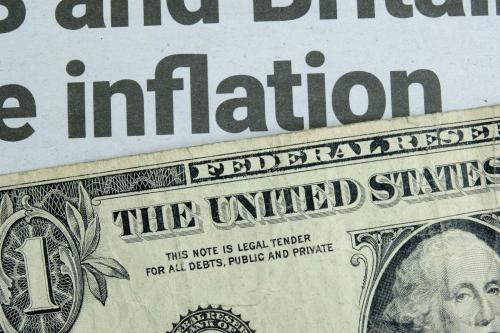The U.S. economy is mired in the doldrums. Five years after the declared end of the recession, the economy is operating well below capacity and has made virtually no progress in narrowing the gap between actual and potential GDP. Given that household consumption accounts for more than two-thirds of total output, it is only natural that measures of consumer spending are among the most closely watched economic indicators. But the problems of a weak recovery are not rooted in consumers’ behavior or their unwillingness to spend as in the past. The United States leads the world in the share of its GDP that is devoted to personal consumption—it is after—all a consumption-based society, and the share continues to rise, even above the boom years of the mid-2000s. Consumer spending is not growing as rapidly as in the years prior to the Great Recession, but the explanation lies with the lack of growth in jobs and incomes.
The household saving rate has followed a path of long-term decline, falling from an average of 10% and more of income in the early 1980s and prior decades to a low of 3% in the mid-2000s. The recession of 2008-09 was a major shock with dramatic loses of jobs, incomes, and household wealth, all of which contributed to the fall in consumption in 2009. It also has contributed to more prudent consumer behavior in recent years: saving rates have rebounded to 5-6% of disposable income. While that is still low relative to the long-term rate, it will be much more sustainable in the future. Consumer spending has surpassed it pre-recession peak, but it is only growing at a 2% annual rate.
The ongoing problem for consumers is that their incomes have not kept up with the growth in total income: their share of GDP in the form of pre-tax earned income fell sharply during the recession and has not recovered. Labor compensation is at its lowest share of GDP in the last half century, and other forms of market incomes (pre-tax, pre-transfers) have experienced equivalent declines. The weakness of earned income is directly traceable to the failure to generate a recovery of the job market. The unemployment rate soared to near 10 percent at the beginning of the recession, and, while total employment is now rising, it has only matched the increase in the working population, and any reduction in unemployment has been the result of workers leaving the labor force, rather that transitioning into reemployment.
Yet, the loss of market income has been more than offset by a dramatic expansion of net transfer payments from government to households, which has pushed the shared of GDP devoted to disposable income in the opposite direction. Following the recession, transfers in the form of unemployment insurance, food stamps, and Medicaid were all expanded, and the share of income paid in income taxes has steadily fallen since passage of the Bush tax cuts in 2001. Thus, the share of GDP devoted to disposable income is at an historical peak, at the same time when the share of earned income is at an historical low—a truly unprecedented dependency on net transfers from government.
However, the tax and transfer programs are now in the process of being scaled back. Income taxes were increased in 2013, and the major transfer programs, outside of Medicaid, are scheduled to be reduced in 2014. This will make households, particularly those in the lower portions of the income distribution, more dependent on their own earnings. On the other hand, households have made more progress in strengthening their financial position. While they lost a fifth of their net worth in the collapse of home prices and equity values in the recession, the ratio of household net worth to disposable income, fueled by a booming equity market, has nearly recovered to its pre-recession level. Along with the revival of equity prices, the ratio of household debt to income has been substantially reduced. Real estate values have been rising for the past two years, even if they remain well-below the pre-recession peak. The improvement in household wealth should a major source of stimulus to consumption going into the new year.
Changes in income and wealth are the two primary drivers of consumer spending. The gain in consumer wealth is a major positive, but fiscal adjustments will constrain the growth in consumer incomes, offsetting much of what is expected to be only a slowly improving job market in 2014.



Commentary
A Failed Economic Recovery: Don’t Blame Consumers
December 19, 2013